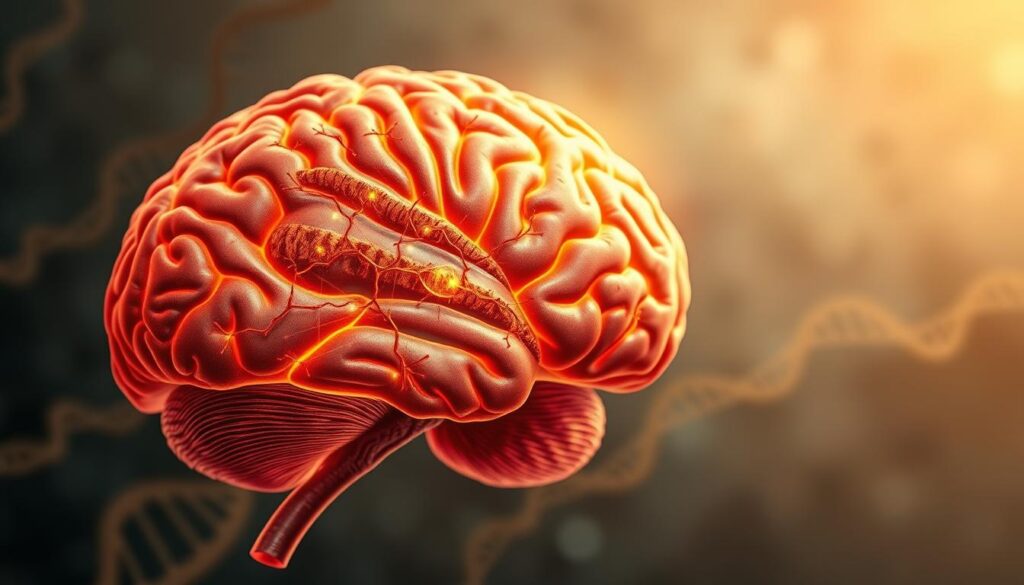Have you ever wondered why some people feel compelled to repeat certain actions or thoughts, even when they know it doesn’t make sense? This behavior is often linked to a mental health condition that affects millions of Americans. Known as OCD, it involves persistent, unwanted thoughts and repetitive behaviors that can disrupt daily life.
OCD is more than just a preference for order or cleanliness. It’s a chronic condition that can cause significant distress. Early diagnosis and proper treatment can lead to a better quality of life. In fact, studies show that about 70% of individuals experience symptom improvement with the right approach.
This article will explore the key symptoms, effective treatments, and practical coping strategies for managing OCD. Whether you’re seeking information for yourself or a loved one, understanding this condition is the first step toward finding relief.
Key Takeaways
- OCD is a chronic mental health condition affecting 2-3 million Americans.
- It involves intrusive thoughts (obsessions) and ritualistic behaviors (compulsions).
- Early intervention can significantly improve outcomes.
- Common misconceptions include confusing OCD with perfectionism.
- Treatment options are effective, with 70% of individuals showing improvement.
What is Obsessive Compulsive Disorder (OCD)?
Living with constant, unwanted thoughts can be overwhelming and exhausting. For individuals with OCD, these thoughts, known as obsessions, are often accompanied by repetitive behaviors, or compulsions, that feel impossible to resist. Unlike everyday habits, these actions consume more than an hour of daily life, as outlined in the DSM-5 criteria.
It’s important to differentiate OCD from Obsessive-Compulsive Personality Disorder (OCPD). While OCD is ego-dystonic—meaning the thoughts and behaviors feel foreign and distressing—OCPD is ego-syntonic, where the person sees their actions as part of their identity. This distinction is crucial for accurate diagnosis and treatment.

Research shows that OCD has a neurobiological basis. Imbalances in serotonin levels and abnormalities in the orbitofrontal cortex are key factors. These findings help explain why people with OCD struggle to control their thoughts and actions.
Despite its prevalence, OCD is often misunderstood. Many view it as a quirk or a preference for order. In reality, it’s a serious mental disorder that causes significant distress. According to the NIMH, there’s an average 17-year delay between symptom onset and treatment, highlighting the need for greater awareness.
In children, a subtype called PANDAS can occur after strep infections, leading to sudden OCD symptoms. Globally, OCD affects 2.3% of the population, while in the U.S., it impacts 1.2% of adults. These statistics underscore the importance of early intervention and proper care.
Common Symptoms of OCD
Unwanted thoughts and repetitive actions can take over a person’s routine. These symptoms are often linked to obsessions and compulsions, which are the core features of OCD. About 60% of individuals experience both, according to the NIMH. Understanding these symptoms is key to recognizing the condition.

Obsessions: Unwanted Thoughts and Urges
Obsessions are intrusive mental images or thoughts that cause significant distress. For example, someone might fear contamination from germs or worry about harming others, even if they are nonviolent by nature. These thoughts are often irrational but feel impossible to ignore.
Common themes include contamination (35%), harm (25%), and symmetry (15%). Some people experience “pure O” OCD, where obsessions occur without visible compulsions. These intrusive thoughts can lead to heightened anxiety, making daily life challenging.
Compulsions: Repetitive Behaviors
Compulsions are repetitive actions performed to reduce anxiety caused by obsessions. These rituals might include excessive handwashing, checking locks, or arranging items in a specific order. While these behaviors provide temporary relief, they often reinforce the cycle of OCD.
For instance, someone with a fear of contamination might wash their hands repeatedly. Over time, these actions can consume hours of the day, interfering with work, relationships, and overall well-being.
Causes and Risk Factors of OCD
The development of OCD is influenced by a mix of genetic and environmental factors. Understanding these causes can help in managing its impact effectively. Research shows that both biology and life experiences play a significant role.

Genetic and Biological Factors
Genetic factors are a major contributor to OCD. Studies highlight that first-degree relatives have a 4-8 times higher risk of developing the condition. Twin studies reveal a heritability rate of 45-65%, pointing to a strong genetic link.
Specific gene clusters, like chromosome 9p24, are associated with OCD. Additionally, abnormalities in the brain‘s glutamate system are often found in treatment-resistant cases. These findings suggest that biological factors are deeply intertwined with the condition.
Environmental Triggers
Environmental factors also play a crucial role. Childhood trauma increases the odds of developing OCD by three times. Stressful situations, such as major life changes, can also trigger symptoms.
For children, certain infections, like strep throat, have been linked to sudden OCD symptoms. This highlights the importance of early intervention and understanding the full range of contributing factors.
How is OCD Diagnosed?
Diagnosing a mental health condition involves careful evaluation and understanding of symptoms. For OCD, this process is guided by specific criteria outlined in the DSM-5. Professionals look for persistent thoughts behaviors that consume more than an hour daily and cause significant impairment.

Diagnostic Criteria
The DSM-5 requires symptoms to last for more than two weeks to confirm a diagnosis. These symptoms include intrusive mental images and repetitive actions. Tools like the Y-BOCS (Yale-Brown Obsessive Compulsive Scale) help assess the severity of these behaviors.
It’s also essential to rule out other conditions, such as Generalized Anxiety Disorder (GAD) or Post-Traumatic Stress Disorder (PTSD). This differential diagnosis ensures the correct treatment path is chosen.
Professional Evaluation
A thorough evaluation by a mental health professional is crucial. They assess the duration, intensity, and impact of symptoms on daily life. For children, sudden onset of symptoms, especially after infections like strep throat, can be a red flag.
Understanding the diagnostic process helps clarify the way forward. Early and accurate diagnosis is key to effective treatment and improved quality of life.
Treatment Options for OCD
Finding effective ways to manage symptoms can make a significant difference in daily life. Treatment for OCD often involves a combination of therapy and medication, tailored to individual needs. With the right approach, many people experience significant improvement in their symptoms.

Cognitive Behavioral Therapy (CBT)
CBT is one of the most effective treatments for OCD. It focuses on changing thought patterns and behaviors. A specific type of CBT, called Exposure Response Prevention (ERP), is particularly successful.
ERP involves gradually exposing individuals to their fears while preventing the usual compulsive response. For example, someone afraid of germs might touch a doorknob and resist washing their hands. Over time, this helps reduce anxiety and break the cycle of OCD.
Modern ERP also incorporates the inhibitory learning model, which focuses on creating new, positive associations with feared situations. Mobile apps like nOCD can support ERP homework, making it easier to practice skills outside of therapy sessions.
Medication and Other Therapies
Medication can also play a key role in managing OCD. Selective Serotonin Reuptake Inhibitors (SSRIs) are commonly prescribed and effective in 40-60% of cases. These medications help balance chemicals in the brain, reducing symptoms.
For those who don’t respond to SSRIs, other options like antipsychotics or alternative therapies may be considered. Combining medication with therapy often yields the best results, with 70% of individuals showing improvement.
Exploring these treatment options can provide hope and a path toward recovery. Early intervention and consistent effort are key to managing OCD effectively.
Living with OCD: Coping Strategies
Managing daily life with OCD requires practical strategies and a strong support system. While the condition can be challenging, adopting effective techniques can help reduce its impact. With the right tools and support, many people find ways to regain control and improve their quality of life.

Daily Management Techniques
One effective method is the “OCD voice” externalization technique. This involves recognizing intrusive thoughts as separate from oneself. By labeling these thoughts as the “OCD voice,” individuals can distance themselves and reduce their power.
Stimulus control is another helpful approach. Modifying the environment to minimize triggers can make a big difference. For example, keeping cleaning supplies out of sight can reduce the urge to wash hands excessively.
Thought record worksheets are also useful. Writing down intrusive thoughts and challenging their validity can help break the cycle. Wearable tech, like smartwatches, can track compulsions and provide data for better management.
Mindfulness practices, such as meditation, have been shown to reduce relapse by 38%. These techniques help individuals stay present and reduce anxiety in triggering situations.
Building a Support System
Having a strong support network is crucial. Friends and family can provide encouragement and understanding. NAMI support groups, available nationwide, offer a safe space to share experiences and learn from others.
Professional care is also essential. Therapists can guide individuals through techniques like ERP and mindfulness. Over time, consistent effort and support can lead to significant improvement.
By combining daily management techniques with a strong support system, people with OCD can navigate their challenges more effectively. These strategies provide hope and a path toward a better quality of life.
Supporting a Loved One with OCD
Supporting someone with OCD can be both rewarding and challenging. It requires patience, understanding, and a willingness to learn about their unique struggles. By offering the right kind of help, you can make a significant difference in their recovery journey.
Understanding Their Experience
One of the first steps in supporting a loved one is understanding their experience. Many people with OCD feel misunderstood or judged. Avoid phrases like “Just stop doing it,” as they can be harmful and dismissive.
Family accommodation, such as participating in rituals to reduce their anxiety, can worsen symptoms in 88% of cases. Instead, focus on validating their feelings without enabling compulsions. For example, acknowledge their fear of contamination but encourage them to resist excessive handwashing.
Encouraging Treatment and Recovery
Encouraging treatment is crucial for recovery. Help them find a therapist who specializes in OCD. Cognitive Behavioral Therapy (CBT) and Exposure Response Prevention (ERP) are highly effective approaches.
Be patient during their journey. Recovery takes time, and setbacks are normal. Offer support without pressuring them. Phrases like “I’m here for you” or “We’ll get through this together” can provide comfort.
By understanding their experience and encouraging the right way forward, you can help your loved one manage their symptoms and improve their quality of life.
OCD in Children and Adolescents
Children and adolescents often experience OCD differently than adults. Their symptoms can be subtle, making early recognition crucial for effective intervention. Understanding these unique challenges helps parents, teachers, and caregivers provide the right support.
Recognizing Symptoms in Young People
In young individuals, OCD may involve “magical thinking” compulsions. For example, a child might believe stepping on cracks will harm a loved one. These behaviors are often irrational but feel necessary to the child.
It’s important to differentiate OCD rituals from autism spectrum behaviors. While both involve repetitive actions, OCD rituals are driven by anxiety, whereas autism behaviors are often self-soothing. School accommodations, like 504 plans, can help manage these challenges.
Consider the case of a 9-year-old with contamination fears. This child avoided touching doorknobs and washed their hands excessively. Early intervention and school support helped them manage their symptoms effectively.
Treatment Approaches for Children
For children under 12, Cognitive Behavioral Therapy (CBT) is often modified with play therapy. This approach makes therapy engaging and age-appropriate. It helps children understand and manage their obsessive thoughts in a safe environment.
Parents and caregivers play a vital role in treatment. By creating a supportive home environment, they can help their child build coping skills. Early treatment can significantly improve long-term health outcomes.
With the right strategies, children and adolescents with OCD can thrive. Recognizing symptoms early and seeking professional help are key steps toward recovery.
Myths and Misconceptions About OCD
Many believe OCD is just about being overly tidy, but it’s far more complex. In reality, only 2% of individuals with this condition have symptoms solely related to organization. The majority face intrusive thoughts and repetitive behaviors that go beyond cleanliness.
One common myth is that all “neat freaks” have OCD. This stereotype oversimplifies the condition. Clinical OCD involves distressing obsessions and compulsions that interfere with daily life, not just a preference for order.
Cultural references, like memes, often misuse the term OCD. These portrayals trivialize the struggles of people living with the condition. It’s important to separate clinical OCD from casual, everyday habits.
Another misconception is that individuals can simply use self-control to stop their behaviors. This advice fails to address the neurological basis of OCD. Telling someone to “just stop” ignores the complexity of their situations.
Some assume OCD is a permanent disability. However, studies show that 40% of individuals achieve remission with proper treatment. Recovery is possible with the right way forward, including therapy and medication.
Understanding these myths helps create a more supportive environment for those affected. By debunking misconceptions, we can foster empathy and encourage effective treatment.
Research and Future Directions in OCD Treatment
Advancements in medical research are paving the way for innovative treatments for OCD. Scientists are exploring groundbreaking therapies that could transform how this condition is managed. From cutting-edge technologies to novel medications, the future looks promising for those seeking relief.
Emerging Therapies
One of the most exciting developments is psilocybin-assisted therapy, currently in Phase III trials by COMPASS Pathways. Early results suggest it could help reduce symptoms by targeting the brain‘s serotonin pathways. This approach offers hope for individuals who haven’t responded to traditional treatments.
Deep brain stimulation (DBS) is another promising option. Studies show a 55% response rate, making it a viable alternative for severe cases. DBS involves implanting electrodes in specific brain regions to regulate abnormal activity, providing long-term relief.
Other innovative treatments include ketamine infusions, CRISPR gene editing, and virtual reality (VR) exposure therapy. Ketamine has shown rapid effects in reducing symptoms, while CRISPR holds potential for correcting genetic abnormalities linked to OCD. VR therapy offers a safe environment for practicing exposure response techniques.
Ongoing Studies
Researchers are also investigating the gut-brain connection. Studies suggest that the gut microbiome may influence OCD symptoms, opening new avenues for treatment. Probiotics and dietary interventions could become part of future therapies.
Ongoing trials are exploring the effectiveness of these treatments over time. The goal is to provide more personalized and effective care for individuals with OCD. As these studies progress, they could revolutionize how we understand and treat this condition.
With continued investment in research, the future of OCD treatment looks brighter than ever. These advancements offer hope for better outcomes and improved quality of life for millions of people.
Conclusion
Recovery from obsessive compulsive disorder is possible with the right care and support. Studies show that 65% of individuals achieve meaningful improvement through combined treatments like therapy and medication. Neuroplasticity—the brain’s ability to adapt—offers hope for long-term recovery.
If you or a loved one is struggling, reach out to the 988 Suicide & Crisis Lifeline for immediate help. Advocacy groups like the IOCDF provide resources and community support, empowering people with OCD to take control of their life.
Exciting research advancements, including psilocybin therapy and deep brain stimulation, are paving the way for innovative treatments. With ongoing progress in mental health care, the future looks brighter for those affected by OCD.
FAQ
What is Obsessive Compulsive Disorder (OCD)?
OCD is a mental health condition characterized by unwanted thoughts and repetitive behaviors. These can interfere with daily life and cause significant distress.
What are the common symptoms of OCD?
Symptoms include persistent, intrusive thoughts (obsessions) and repetitive actions (compulsions) performed to reduce anxiety. Examples include excessive cleaning or checking behaviors.
What causes OCD?
The exact cause is unknown, but factors like genetics, brain chemistry, and environmental triggers may contribute to its development.
How is OCD diagnosed?
A mental health professional evaluates symptoms based on specific criteria, such as the presence of obsessions, compulsions, and their impact on daily functioning.
What are the treatment options for OCD?
Treatment often includes Cognitive Behavioral Therapy (CBT), specifically Exposure Response Prevention (ERP), and medications like SSRIs to manage symptoms.
How can someone manage OCD in daily life?
Techniques include practicing mindfulness, setting routines, and seeking support from therapists or support groups to reduce anxiety and improve coping skills.
How can I support a loved one with OCD?
Educate yourself about the condition, offer patience and understanding, and encourage them to seek professional help for effective treatment.
Can children and adolescents have OCD?
Yes, OCD can affect young people. Symptoms may include excessive handwashing, fear of harm, or rigid routines. Early intervention is crucial for effective management.
What are some myths about OCD?
Common misconceptions include thinking OCD is just about being overly clean or organized. In reality, it involves severe anxiety and intrusive thoughts that disrupt daily life.
What are the future directions in OCD treatment?
Ongoing research focuses on emerging therapies like deep brain stimulation and new medications to improve treatment outcomes for individuals with OCD.






